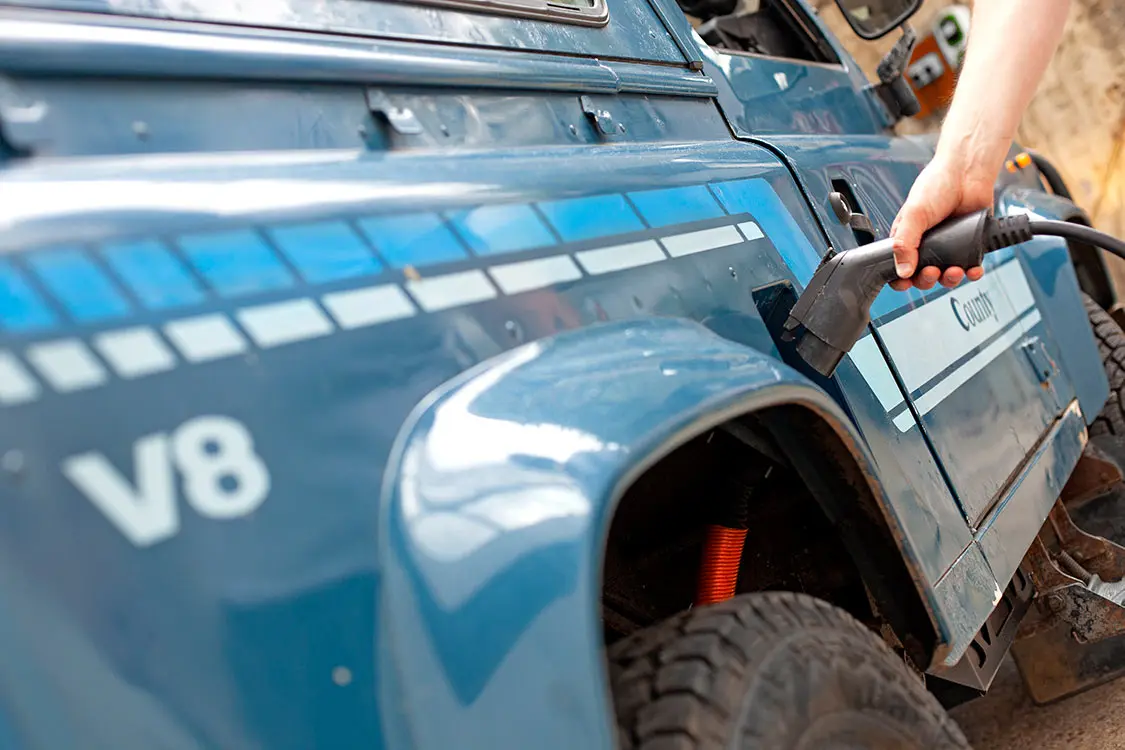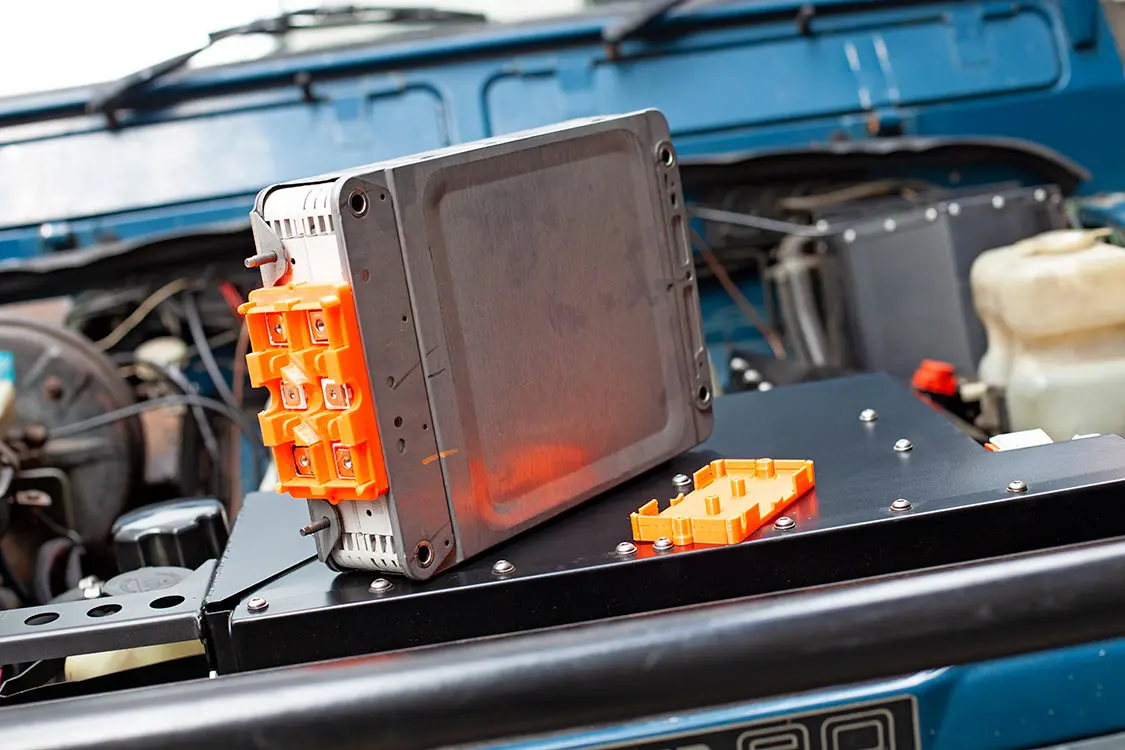 Jerome Andre
.
August 14, 2023
.
All EV Vehicles
Jerome Andre
.
August 14, 2023
.
All EV Vehicles

Replacing a Land Rover’s powertrain is not new; even equipping it with an electric motor is not. Land Rover did it in 2013 with a limited run of “research vehicles.” Since there was only a handful of converted Defenders in the world, specialists such as London Electric Cars have recently been offering turnkey solutions, converting any Defender to e-power.
According to Matthew Quitter, who founded LEC in 2017, it is, in fact, reasonably straightforward … “well, once you have done it a few times.” Matt even compares it to assembling a remote-controlled electric model car. The components and systems are remarkably similar.


Matthew and his team repurpose Nissan’s EV technology from its bestselling Leaf. This follows the circular economy concept: recycling, retrofitting, and stopping wasting. Some might argue that’s old news for Land Rover owners since they tend to keep their pride and joy for decades, preserving them regardless of cost. But this goes further and applies to all types of classic cars, and eventually, large-scale retrofitting.

Recycling does not mean you cannot embrace modern technologies and production techniques. Matthew leads a team of CAD designers and automotive engineers using the latest top-notch tools. They produce their own parts thanks to on-site 3D printing, or they get them milled out of aluminum blocks in the UK capital.


To convert each vehicle model, they scan the engine bay, undercarriage, and chassis to design scalable solutions for consecutive builds and speed up the prototyping process. Not so long ago, all these technologies were reserved for OEMs. The next step is to prepare the recommissioned Nissan powertrain. Again, the team covers the whole process in-house, from stripping a complete, written-off Nissan Leaf to reprogramming its brain to work as a stand-alone unit in the Defender.
After four years of R&D, the LEC team found ways to repurpose most components from the Leaf. For example, they reuse the battery management system instead of a standard aftermarket unit. They can even program it to handle more or less battery capacity, depending on the vehicle and its desired range—a feat in itself. That said, on this 90, a full 2017 Nissan battery pack was used that contained 24 modules.

Under the hood, we find the Nissan motor and its inverter on top of it, still bearing its Nissan logo.
Next to it sits the 12-volt fuse box. An aftermarket electric pump circulates coolant through the original radiator, the inverter, and the motor. However, unlike most EVs, the Nissan battery modules do not require water cooling, simplifying the conversion.
The Defender’s character is preserved with all its sounds, vibrations, and rattles!

While the overall additional weight of the system is only around 200 pounds, its distribution is critical on a Defender—as much as it is on more spirited driving-focused classics. Most retrofitters maintain the original weight distribution or bring it slightly closer to 50/50. So Defender 90s, one part of the battery pack is installed in a heavy-duty steel box under the driver seat, while the rest is fitted beneath the boot’s floor plan, away from rocks and debris.
Whatever the configuration, Matt is adamant the conversion should never reduce the interior space. In fact, may it be from the exterior or interior, besides the lack of exhaust tip and one micro–LCD screen on the dash, you could hardly tell this has been retrofitted. Even the “fuel filler” is covered, not showing the Type 1, 32A charge port beneath.

A Defender 90 is relatively compact compared to modern SUVs, and you see above most urban jungle obstacles in your way, which “posh” Londoners seem to love. However, Matt is surprised to meet more cultivators and land managers requiring full EV Land Rovers. This 1986 County 90 belongs to farmer Oliver Stapleton. He loves it but uses it for what it was made daily; hence why it wears, and will keep, its original patina (some might say battle scars!).

LEC’s next 90 build is for an organic farm willing to go zero-emission. They are also converting an adventure-prepped 110. These might never see the London streets once completed.
That said, Matt and his team also have in their clientele four-star hotels, celebrities, and members of the UK parliament, all seduced by the idea of carrying on driving iconic classics without the guilt of polluting—or the fear of them not starting in the morning.
With Defender conversion starting at $38,000, committing to swapping your old V-8 to a Nissan powertrain may not appear as a cheap solution. However, if you live in the some of the world’s largest cities, such as London, the conversion pays for itself in less than three years in congestion fees and ultra-low emission zone charges alone. And that’s without considering the thousands of dollars you’d otherwise spend on gas and in some aspect on servicing. Since this 90 retains its original transmission and axles, there will still be some maintenance, but no more regular oil and filter changes.

Also, 38 grand plus a donor Defender is still significantly less than what Land Rover will charge when it eventually offers the new Defender in a full-electric configuration, which will cost three to four times that. More importantly, retrofitting lets you keep your own iconic and beloved Defender.
The only major drawback is you will have to do without your Landy for the best part of six months while the team works its magic. While they are at it, they may proceed with any essential remedial work, such as chassis welding repairs, but Matt is adamant that they avoid restoration work. They bring value in the conversion but would rather let model or brand-specific specialists restore a classic before the retrofit. Note that all of the electric drivetrain can be removed and the vehicle returned to original specs without leaving a bracket or a weld. London Electric Cars does not modify the chassis or cut the bodywork. They would rather build dedicated fittings to install the new running gear.

The regenerative braking system on the 90 works very well, if a bit on the strong side. It feels like engine braking on a diesel Defender—in low gear! It only takes a minute to get used to it. You soon realize you mainly use the right pedal and only press the brakes in case of an emergency or to stop the car entirely at a light. Now, when you press the right pedal, even in third or fourth gear from a standstill, you’ll leave a V-8 Defender in the dust! And this 90 is not even tuned for performance but farmland use.
To start driving, turn on the ignition key, select a gear without pressing the clutch pedal, then ease on the accelerator. Then you almost drive it like an automatic car. Of course, you can change gears to reduce noise at higher speeds, but the electric motor whining sound is still quieter than a diesel Land Rover idling. And don’t worry—the Defender’s character is preserved, with all its sounds, vibrations, and rattles.

Now, the elephant in the room is that you lose the V-8 rumble. True, but that’s about the only trade-off. Then again, “filling up” the EV 90 cost a few bucks at home overnight versus $100 at the gas station. You decide.
The Nissan motor produces 80kW (107hp) and 285Nm (210 lb-ft), a perfect match for the 90’s anticipated use. It compares to the sought-after four-cylinder diesel 200 Tdi at 107hp and 198 lb-ft or 300 Tdi at 111hp and 205 lb-ft. It is not far off the more recent 5-cylinder Td5’s 121hp and 221 lb-ft either.
The original 3.5L V-8 delivered 134hp and 187 lb-ft. Well, it did back in 1986, so probably significantly less before being extracted from the 90. All in all, it roughly compares to most Defender powertrains, with a caveat: You can use the max torque from 0 rpm, meaning as soon as you press the pedal, you get all the grunt you would get from a 4-cylinder turbo diesel with none of the fume and smell.
Driving in London’s heart at the wheel of a peppy Defender, hopping between landmarks in relative silence, is quite an experience. The city’s ultra-low emission zone is typically the private turf of cabs, buses, delivery vans, and EVs. Our rough-around-the-edges 90 does stand out, in an exhilarating way, and saving on charges is a bonus. Several passers-by and even a double-decker bus driver hailed at us for a quick chat, figuring something was off with our surprisingly quiet Defender. We got a few thumbs up at the stop lights too. Now, you could smoke most cars when the red turns green, but, at first, we opted to taking it easy and enjoying the scenery. This considerably helps saving on the modest 30 kWh battery pack’s 60-mile range.
The Defender, being a brick on wheels, at higher speeds you are not getting the range you would get from the curvy, streamlined Leaf. Over 50 mph, you are using most of the energy to move air around the front of the Defender. However, the range is significantly less altered by the vehicle’s shape in town, around the farm, or woodland.

A rough consumption figure for a Defender is 500W per mile in real-life use. This is twice what the latest high-end compact EVs use—just like an internal combustion engine Defender needs twice as much fuel as a smaller, lighter car.
Arguably, if you are just pottering around, not accelerating aggressively, you can get better than 500W/mile, but I did not manage today as I eventually found myself racing everybody! For other applications, Matthew can offer up to 150 miles of range on 110 and 130 Defenders.
What a time to be alive.

Model: 1986 Land Rover 90 County SW 3.5L V-8
Conversion: London Electric Cars, UK
Time to Build: Six months
Cost to Build: $38,000
Motor Drive: 2017 Nissan EM57
Power: 80kW (107hp)
Torque: 285Nm (210 lb-ft)
Motor Mounts: Custom London Electric Cars onto original Land Rover mounts
Control Software: LEC proprietary software
Battery: Nissan Leaf NMC 30kWh modules repackages in two packs
Amp-Hours: 79Ah
Information: LondonElectricCars.com
Share Link